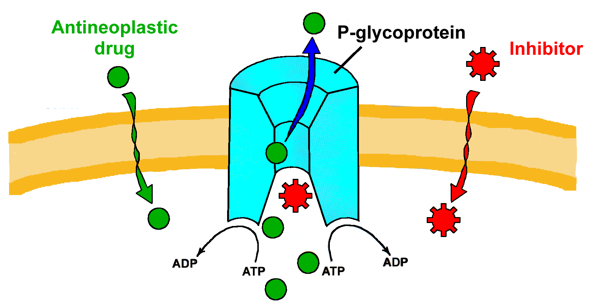P-glycoprotein (P-gp), an efflux membrane transporter, is widely distributed throughout the body including the apical surface of epithelial cells lining the colon, small intestine, pancreatic duct, bile duct, kidney proximal tubule, and the adrenal gland. It is also located in the endothelial cells of the blood brain barrier (BBB). P-gp contributes greatly in the extrusion of many drugs from the blood into the intestinal lumen. P-gp is also responsible for promoting drug excretion from hepatocytes and renal tubules to adjacent luminal space. Therefore, P-gp can potentially reduce the absorption and oral bioavailability and shorten the retention time of a number of drugs. In addition, it has a role in limiting cellular uptake of drugs from blood circulation into the brain while being present in the BBB. P-gp is overexpressed in cancer cells, leading to drug efflux. It prevents cell internalization of chemotherapeutic agents, making the chemotherapy almost ineffective in many cases. Hence, this protein is one of the major obstacles to chemotherapy. Various strategies are currently being developed to overcome the difficulties associated with P-gp in optimal drug delivery, including inhibition of P-gp.

Techniques for P-gp Inhibition
Several techniques are available for screening chemical entities for their ability to inhibit P-gp. These techniques are also useful for detecting the substrate specificity to the P-gp and the significance of the protein in altering pharmacokinetics, further contributing to the selection of drug candidates and optimization of drug discovery settings. Based on the ultimate objective of the study, the strategic application of these methods will help in high throughput and better optimization.
- Intestinal or cultured monolayers efflux assay
- Drug accumulation and efflux assay
- ATPase assay
- Labeling and binding assay
Cell Lines for P-gp Inhibition Assays
In vitro assessment of P-gp inhibition is important for choosing drug candidates that are not likely to cause P-gp-mediated drug-drug interaction (DDI) during the drug discovery stage. Scientists from Creative Bioarray have established several in vitro systems for P-gp inhibition assays to predict P-gp-mediated DDI.
- Caco-2
- Human colon carcinoma cell line
- Morphologically similar to small intestinal epithelial cells
- Most extensively characterized human cell-based model for investigating permeability and P-gp transport of drugs
- Various uptake and efflux transporters are expressed in Caco-2 cells, however, P-gp is functionally the most predominant
- No wild-type cells to run alongside - LLC-PK1-MDR1
- Transfected porcine kidney cell line
- Low transporter background, especially for P-gp - MDCK-MDR1
- Transfected canine kidney cell line
- High background dog P-gp activity
References
- Varma M. P-glycoprotein inhibitors and their screening: a perspective from bioavailability enhancement. Pharmacological Research, 2003, 48(4): 347-359.
- Amin M. L. P-glycoprotein inhibition for optimal drug delivery. Drug Target Insights, 2013, 7: 27-34.